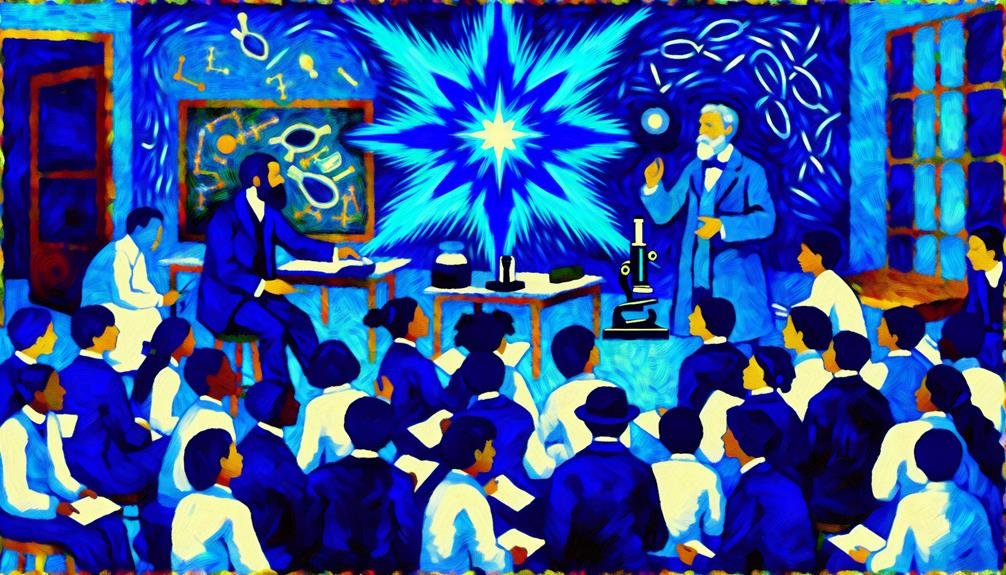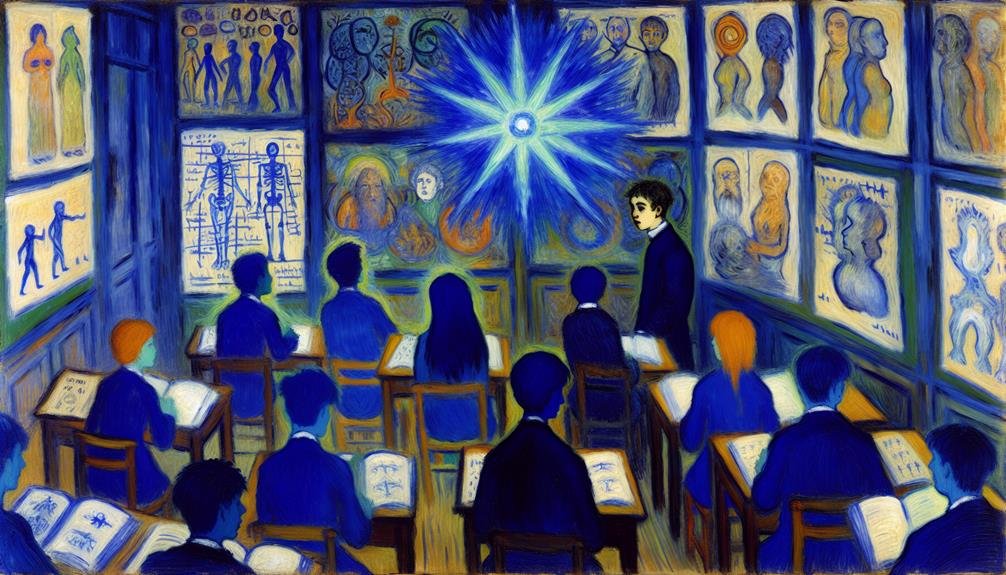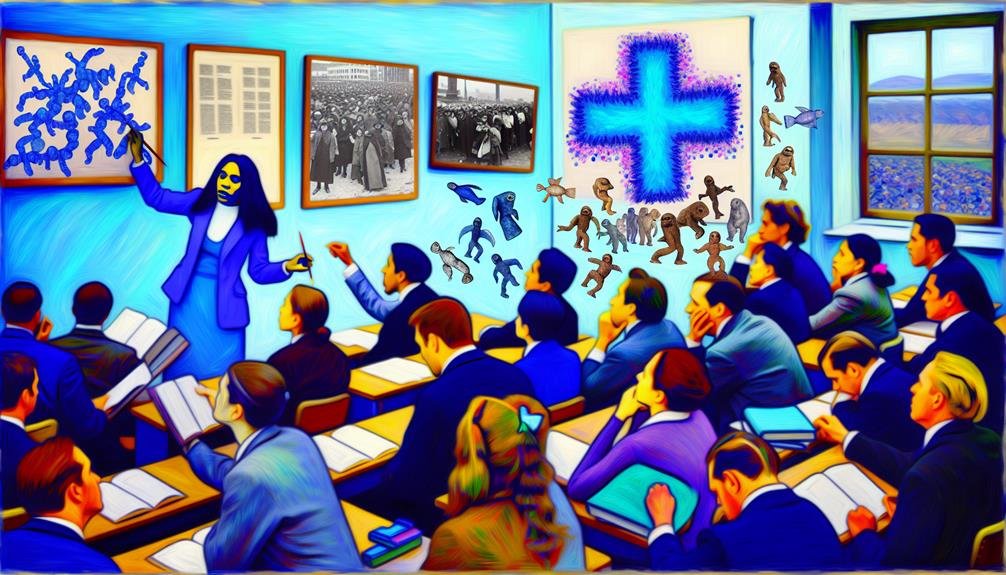Imagine this: you get a front-row seat to witness how living things have transformed and adapted over eons. It’s like watching a thrilling movie unfold right before your eyes—drama, action, and science all in one! But hold your horses, there’s a twist too. Some sticky situations may arise, like debates on creationism or conflicting beliefs. Interested to uncover more about the wild ride of teaching evolution? Keep those eyes peeled, and you might just uncover some fascinating insights!
Takeaways
- Enhances critical thinking skills and scientific literacy.
- Raises religious conflicts and controversies.
- Fosters understanding of the natural world.
- Upholds academic integrity and scientific consensus.
- Encounters challenges in implementation and acceptance.
Benefits of Teaching Evolution
The inclusion of evolution in school curricula offers students a foundational understanding of the biological processes that have shaped life on Earth. By learning about evolution, students are given a window into the fascinating journey of how different species have adapted and changed over millions of years. It’s like uncovering a mystery novel filled with twists and turns, except this story is written in the language of genes and survival of the fittest.
Moreover, teaching evolution helps students develop a deeper appreciation for the interconnectedness of all living things. They begin to see how a tiny bug in the Amazon rainforest can have an impact on the ecosystem halfway across the globe. This broader perspective fosters empathy and environmental awareness, encouraging students to become stewards of our planet.
In addition, understanding evolution equips students with the knowledge to critically analyze information and make informed decisions based on evidence. It’s like having a superpower that allows them to sift through fake news and pseudoscience with ease. By honing their scientific literacy, students become equipped to face the challenges of our rapidly evolving world with confidence and clarity.
Critical Thinking Skills Development
Developing critical thinking skills through the study of evolution enhances students’ ability to evaluate evidence, think analytically, and draw logical conclusions based on scientific principles. By delving into the intricacies of evolution, students are prompted to question, analyze, and interpret information critically. As they explore the concept of natural selection and genetic variation, they learn to sift through data, identify patterns, and construct well-supported arguments.
Imagine a classroom buzzing with excitement as students passionately debate the mechanisms of evolution, presenting evidence to support their viewpoints. Through such discussions, young minds are honed to think logically, consider various perspectives, and challenge assumptions. These skills extend beyond the domain of science and become invaluable tools in everyday life, empowering students to make informed decisions based on evidence and reason.
In essence, teaching evolution not only broadens students’ scientific knowledge but also equips them with the essential skill of critical thinking, fostering a generation of curious, analytical, and open-minded individuals ready to tackle the challenges of the modern world.
Understanding of Natural World

Enhancing students’ comprehension of the natural world, specifically through the lens of evolution, provides a foundational framework for understanding the interconnectedness of living organisms and their environments.
By learning about evolution, students grasp how species adapt to their surroundings over time, like a game of biological musical chairs where the fittest find a seat. Imagine the Galapagos finches competing for the best seeds, their beaks evolving to fit specialized diets – it’s like a buffet where only the beaked can eat!
This understanding goes beyond just animals; it extends to plants, fungi, bacteria, and even viruses – the whole shebang of life on Earth!
Picture a web where every species is a thread, linking and depending on each other for survival. It’s like a giant jigsaw puzzle where every piece, no matter how small, is essential for the picture to be complete.
Controversy and Religious Conflicts
Managing the integration of evolution education in schools often brings to light the complexities surrounding controversies and religious conflicts. Evolution, with its focus on natural selection and the development of species over time, can clash with certain religious beliefs that emphasize divine creation. This clash can spark heated debates and passionate arguments, with some feeling that teaching evolution undermines their faith while others see it as an essential aspect of scientific education.
In the midst of this swirling controversy, educators must navigate carefully, balancing the need to provide students with a thorough understanding of the natural world while respecting diverse beliefs and viewpoints. It’s like walking a tightrope, trying to find that perfect equilibrium where science and faith can coexist harmoniously in the classroom.
Ultimately, addressing these controversies and religious conflicts requires open dialogue, empathy, and a willingness to engage in respectful discussions. By fostering an environment where students feel heard and understood, educators can help bridge the gap between differing perspectives and promote mutual understanding and acceptance.
Academic Integrity and Scientific Consensus

As we explore the domain of teaching evolution in schools, an essential aspect that demands our attention is academic integrity. Upholding honesty and credibility in education is like laying down a sturdy foundation for a skyscraper of knowledge.
Moreover, the consensus within the scientific community acts as a guiding light, illuminating the path toward understanding the intricate mechanisms of evolution.
Integrity in Education
In the domain of education, maintaining academic integrity and upholding scientific consensus are paramount for fostering a reputable and credible learning environment. Academic integrity is like the superhero cape of education, ensuring that students and educators conduct themselves honestly, ethically, and with a sense of fairness. It’s the glue that holds the educational community together, making sure that knowledge is gained through hard work and dedication rather than shortcuts or deception.
Scientific consensus, on the other hand, is like a giant puzzle where all the pieces fit perfectly together to form a beautiful picture of our understanding of the world. It represents the collective agreement among scientists in a particular field and serves as a guiding light for educators to teach the most up-to-date and accurate information to their students.
Scientific Community Agreement
The alignment between academic integrity and scientific consensus within the educational framework is foundational for instilling a culture of trust and reliability in the pursuit of knowledge. When the scientific community reaches a consensus on a particular topic, it signifies that a vast majority of experts in that field have scrutinized the evidence, conducted experiments, and arrived at a collective understanding. This agreement is not based on personal opinions or whims but on rigorous testing, peer review, and reproducibility of results.
Imagine a team of scientists as detectives, each armed with their unique tools and expertise, working together to solve a complex mystery. As they piece together the clues, they debate, challenge each other’s conclusions, and refine their theories until a coherent picture emerges. This collaborative effort embodies the essence of scientific consensus – a shared understanding that has withstood the crucible of scrutiny and emerged stronger and more refined.
Teaching evolution in schools not only imparts scientific knowledge but also showcases the power of collective wisdom and the beauty of evidence-based reasoning. It encourages students to question, investigate, and contribute to the ever-evolving fabric of scientific understanding.
Student Engagement and Interest
Engaging students with interactive and thought-provoking activities is essential for fostering a genuine interest in the topic of evolution within school curriculum. Evolution can be an exciting journey into the past, showing how life forms have changed and adapted over millions of years.
Here are some fun ways to get students excited about learning evolution:
- Fossil Dig: Let students become paleontologists for a day, digging for fossils and piecing together the evolutionary history of different species.
- Evolutionary Timeline: Create a timeline activity where students place key evolutionary events in chronological order, visually seeing how life has evolved over time.
- Adaptation Simulation: Have students participate in a role-playing game where they act out different animal adaptations in a changing environment.
- Debate Evolution: Organize a friendly debate where students argue for or against evolutionary concepts, encouraging critical thinking and discussion.
- Evolutionary Art: Encourage students to express their understanding of evolution through art, creating visual representations of evolutionary concepts.
Challenges in Implementation and Acceptance

Setting out on the journey of teaching evolution in schools is like launching a ship on a turbulent sea, with challenges waiting at every turn.
From the rocky shores of implementation barriers to the stormy seas of parental resistance, educators must navigate these treacherous waters with skill and determination.
Equipping teachers with the necessary training and support becomes the compass guiding them through these uncharted territories.
Implementation Barriers
What obstacles hinder the successful implementation and acceptance of teaching evolution in schools? Implementing the teaching of evolution faces various challenges that can make it a challenging task for educators. Here are some of the barriers they encounter:
- Lack of Teacher Training: Many educators may not have received adequate training on how to effectively teach evolution, leading to a lack of confidence in delivering the curriculum.
- Religious Beliefs: Some individuals may hold strong religious beliefs that conflict with the theory of evolution, making it difficult for them to accept its teaching in schools.
- Curriculum Restrictions: In some regions, there may be restrictions or guidelines that limit the extent to which evolution can be taught, hindering a thorough understanding of the topic.
- Parental Concerns: Parents may express concerns about the teaching of evolution, leading to pushback and resistance from the community.
- Resource Limitations: Schools may lack sufficient resources, such as textbooks, materials, and technology, to effectively teach evolution, impacting the quality of education in this area.
Parental Resistance
Parental resistance poses a significant challenge to the successful implementation and acceptance of teaching evolution in schools, often stemming from concerns or beliefs that conflict with the scientific theory. It’s like attempting to blend oil and water – sometimes beliefs just don’t want to mix!
Imagine this: a passionate teacher ready to delve into the wonders of evolution, only to face a sea of raised eyebrows and concerned frowns from parents who prefer a different flavor of science. It’s a tough nut to crack!
Parents might worry about evolution contradicting their religious beliefs or fear that their children will be exposed to ideas they don’t agree with. It’s understandable; we all want what’s best for our kids. However, finding common ground between scientific education and personal beliefs can feel like trying to tame a wild dragon with a feather duster.
Navigating these choppy waters requires open communication, understanding, and a sprinkle of patience. It’s like a delicate dance where everyone’s steps need to be in sync to create harmony in the educational journey.
Teacher Training Needs
Addressing the challenges in implementation and acceptance of teaching evolution in schools requires a thorough focus on teacher training needs. Teachers play a significant role in effectively conveying scientific concepts, including evolution, to students.
Here are five essential aspects of teacher training needs in this regard:
- Comprehensive Curriculum Understanding: Teachers need in-depth knowledge of evolutionary theory to confidently teach the subject.
- Effective Communication Skills: The ability to explain complex ideas in simple terms and engage students in discussions is important.
- Handling Controversial Topics: Training should include strategies for addressing controversies and handling diverse perspectives in the classroom.
- Professional Development Opportunities: Continuous training and workshops can keep teachers updated on the latest scientific findings and teaching techniques.
- Support Systems: Creating a supportive environment within schools where teachers can collaborate and share best practices can enhance the teaching of evolution.
Frequently Asked Questions
How Does Teaching Evolution Impact Students’ Cultural Beliefs?
Teaching evolution can influence students’ cultural beliefs by introducing concepts that may conflict with traditional beliefs. This can lead to critical thinking, cultural awareness, and potential challenges as students navigate between scientific theory and personal beliefs.
Are There Resources Available for Teachers Facing Parental Objections?
Teachers facing parental objections to teaching evolution can access resources from educational organizations, scientific societies, and legal experts. These resources provide guidance on addressing concerns, communicating effectively with parents, and managing potential conflicts within the educational setting.
Can Teaching Evolution Be Tailored for Different Age Groups?
Tailoring the teaching of evolution for different age groups is crucial to guarantee comprehension and engagement. By adjusting complexity, terminology, and teaching methods, educators can effectively convey this fundamental scientific concept to students of varying developmental stages.
How Can Schools Address the Lack of Teacher Training in Evolution?
To address the lack of teacher training in evolution, schools can implement professional development programs, workshops, and resources specifically tailored to enhance educators’ understanding of evolutionary theory. Collaboration with experts and academic institutions can also provide valuable support.
What Strategies Can Schools Use to Combat Evolution Misconceptions?
To combat evolution misconceptions, schools can implement strategies such as offering thorough teacher training, incorporating interactive and engaging curriculum materials, fostering open discussions, inviting guest speakers, and utilizing technology for visual aids.
Conclusion
In summary, teaching evolution in schools offers students the opportunity to:
- Develop critical thinking skills
- Gain a deeper understanding of the natural world
- Engage in academic discourse
However, it also brings about challenges such as:
- Controversy
- Conflicts with religious beliefs
Despite these challenges, the benefits of teaching evolution far outweigh the drawbacks, as it:
- Encourages curiosity
- Promotes scientific inquiry
- Provides a broader perspective on the world around us
Evolution education is an essential component of a well-rounded education.

